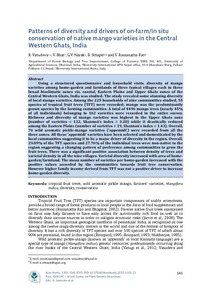Patterns of diversity and drivers of on-farm/in situ conservation of native mango varieties in the Central Western Ghats, India
Using a structured questionnaire and household visits, diversity of mango varieties among home-garden and farmlands of three typical villages each in three broad bioclimatic zones viz. coastal, Eastern Plains and Upper Ghats zones of the Central Western Ghats, India was studied. The study revealed some stunning diversity of local mango varieties. Among the 225 households of nine communities studied, 55 species of tropical fruit trees (TFT) were recorded; mango was the predominantly grown species by the farming communities. A total of 4496 mango trees (nearly 45%of all individuals) belonging to 162 varieties were recorded in the entire survey. Richness and diversity of mango varieties was highest in the Upper Ghats zone (number of varieties = 132, Shannon’s index = 3.20) while it drastically reduced among the Eastern Plains (number of varieties = 19, Shannon’s index = 1.43). Overall, 76 wild aromatic pickle-mango varieties (‘appemidi’) were recorded from all the three zones. All these ‘appemidi’ varieties have been selected and domesticated by the local communities suggesting it to be a major driver of diversity in the region. Overall, 29.09% of the TFT species and 27.76% of the individual trees were non-native to the region suggesting a changing pattern of preference among communities to grow the fruit trees. There was a significant positive association between density of trees and varietal density in all the nine villages. Varietal diversity increased with area of homegarden/farmland. The mean number of varieties per home-garden increased with the positive values accorded by the communities towards fruit tree conservation.
However higher family income derived from TFT was not a positive driver to increase home-garden diversity.

